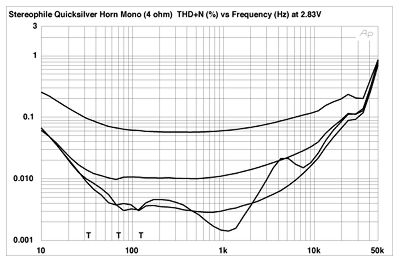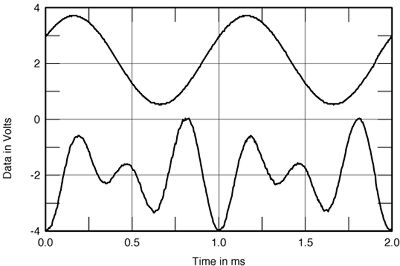| Columns Retired Columns & Blogs |
Quicksilver Audio Horn Mono monoblock power amplifier Measurements
Sidebar 3: Measurements
Compared with the immaculate-looking Hovland Sapphire and Music Reference RM-200 tube amplifiers that preceded it on my test bench, the Quicksilver Horn Mono amplifier, with its three tubes atop its chromed chassis, looked unprepossessing. But you should never go by looks; it's performance that matters, right?
The input impedance at 1kHz was usefully high, at 98k ohms, and the amplifier preserved absolute polarity. No surprises there. However, the voltage gain into 8 ohms measured a very low 8.86dB from the 8 ohm output transformer tap. It was an even lower 5.5dB from the 4 ohm tap, meaning that no less than 1.51V will be required to pull 1W from the amplifier into 8 ohms, and that the maximum "Red Book" CD-player output level of 2V will increase the power level to just 1.75W!
This isn't a bad thing, but those using the Horn Mono will find that their preamplifier's volume control will be set much higher than they're used to with more normal amplifiers. The upside of this low sensitivity is that, as RD found, the Quicksilver is enormously quiet. Even with a very wide measurement bandwidth—<10Hz to >500kHz—the signal/noise ratio (ref. 1W/8 ohms) was 98dB, this increasing to a staggering 116dB when A-weighted. In terms of its gain and noise architecture, the Quicksilver is the best amplifier I have encountered for use with high-sensitivity speakers like horns.
Presumably as a result of the fairly high level of loop negative feedback used, the Horn Mono also has a surprisingly low output impedance for a design using an output transformer: 0.18 ohm across most of the audioband from the 4 ohm tap, rising to 0.22 ohm at 20kHz; and 0.33 ohm and 0.37 ohm, respectively, from the 8 ohm tap. As a result, the modification of the amplifier's frequency response as result of the interaction between its source impedance and the loudspeaker impedance will be moderately low. Even from the 8 ohm tap, the response into our simulated loudspeaker load varied by only +0.2dB, -0.3dB (fig.1). This graph also shows that the response is very slightly more curtailed outside the audioband into 2 ohms than 8 ohms at this 2.83V level. (At lower levels, the response was flat down to the 10Hz limit of this graph.)

Fig.1 Quicksilver Horn Mono, 8 ohm tap, frequency response at (from top to bottom at 2kHz): 2.83V into dummy loudspeaker load, 1W into 8 ohms, 2W into 4 ohms, 4W into 2 ohms (0.5dB/vertical div.).
The ultrasonic rolloff, however, is complex, with a couple of shelves marring what should be a smooth curve. This kind of behavior is associated with the presence of ultrasonic resonances, even though they may be well-damped. A 1kHz squarewave (fig.2) does feature slight overshoots, though the shape of the waveform is superbly square. Repeating this test with a 10kHz squarewave (fig.3) also gives a good square shape, but with one cycle of damped ringing visible on each leading edge. Unusually, the frequency of this oscillation appears different for the positive- and negative-going leading edges, but in either case the spuriae are well above the audioband.

Fig.2 Quicksilver Horn Mono, 4 ohm tap, small-signal 1kHz squarewave into 8 ohms.

Fig.3 Quicksilver Horn Mono, 4 ohm tap, small-signal 10kHz squarewave into 8 ohms.
As Quicksilver claims—and again, this is connected with the use of negative feedback—the Horn Mono circuit is extremely linear. Figs.4 and 5 show how the percentage of THD+noise varies with frequency at 2.83V from, respectively, the 8 and 4 ohm taps. The 4 ohm tap is the winner, with just 0.003% THD+N into 8 ohms throughout the midband. While moderate rises in distortion can be seen above 20kHz and below 20Hz, the overall level remains respectably low in the audioband, at least as long as the load impedance is not less than half the specified output tap. From either tap, there is quite a large dependence of the distortion level on the amount of current drawn from the transformer. (Though it can't be seen in fig.4, the amplifier actually clips below 1W when the 8 ohm tap is used to drive a 2 ohm load.)

Fig.4 Quicksilver Horn Mono, 8 ohm tap, THD+N (%) vs frequency at 2.83V into (from bottom to top at 1kHz): simulated loudspeaker load, 8 ohms, 4 ohms.

Fig.5 Quicksilver Horn Mono, 4 ohm tap, THD+N (%) vs frequency at 2.83V into (from bottom to top at 1kHz): simulated loudspeaker load, 8 ohms, 4 ohms, 2 ohms.
Fig.6 shows that the content of the distortion from the 8 ohm tap is almost pure third harmonic, which will be quite benign in subjective terms, both because of its nature and because of its low level, 0.06% in this graph. From the 4 ohm tap, the third harmonic is joined by other low-order harmonics (fig.7), but, as I noted above, the absolute level of that distortion is even lower: just 0.0027% in this case.

Fig.6 Quicksilver Horn Mono, 8 ohm tap, 1kHz waveform at 3W into 4 ohms (top), distortion and noise waveform with fundamental notched out (bottom, not to scale).

Fig.7 Quicksilver Horn Mono, 4 ohm tap, 1kHz waveform at 750mW into 4 ohms (top), distortion and noise waveform with fundamental notched out (bottom, not to scale).
- Log in or register to post comments



































